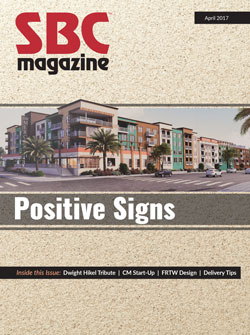Brace Yourself
Brace Yourself
If you’ve been in the truss industry for any length of time, there’s one phone call you absolutely dread receiving: “We have a problem; your trusses collapsed!” With dismay, you send someone out to the jobsite to take pictures, gather information about who did what and try to determine what caused the collapse. The sad thing is that most of the time the collapse was completely avoidable because it was due to improper installation.
If you ask the installers whether they followed the bracing instructions provided in the SBCA jobsite package delivered with the trusses, the finger pointing quickly starts. The typical conclusion is that the installer didn’t follow the bracing instructions or didn’t consult the building designer for guidance on the proper way to apply temporary and permanent bracing to the specific set of trusses in question.
I think that since the first trusses were erected in the 1950s, manufacturers and installers have struggled to find a perfect solution to this issue. Over the years, many experts within our industry have worked to develop the proper method for setting and bracing trusses, and those efforts have resulted in a very thorough set of guidelines for handling, installing and bracing. It’s called BCSI, and if you aren’t including these documents with every job you deliver, you’re taking on way more risk than you should.
Many of us who regularly use BCSI documents in jobsite packages know there are things about these guidelines that could be improved. However, currently it is the best and most complete set of guidance for installers that exists. It addresses most of the issues installers encounter daily on the jobsite and, if it’s followed, the chances of getting that dreaded phone call are reduced to almost zero.
I’m not saying the bracing guidance in BCSI is absolutely perfect. SBCA’s recent conversations with Truss Plate Institute (TPI) members regarding their efforts to update the TPI 3 standard (which is intended to provide a standardized approach to truss bracing) is a reminder there is work to do in updating the guidelines. That work extends to BCSI’s use in the field.
As the dreaded installer call illustrates, it’s a challenge to get jobsite crews to follow the guidelines because the processes outlined in BCSI isn’t as efficient as everyone would like. As a result, installers continue bracing using whatever method they learned when they first got into the business, and there’s no consistent approach.
I think it’s time we work together as an industry to improve the BCSI guidelines so they are more practical to implement in the field. Our goal must be to make the guidelines easier to understand and use, bringing the industry closer to full compliance and making it easy to promote the use of trusses instead of stick framing. While developing those improvements, we need to involve our most important partner: the installer.
Here in Texas, I regularly compete with stick framing. If I can make BCSI guidance easier to implement, it’s going to be easier for me to convince builders to use my product to frame their roofs. That would certainly take my business in the right direction—and that’s the result I’d like for everyone in this industry.
I urge you to talk about bracing with your installers. Find out what they do to ensure your products are safely installed on the jobsite. What do they find helpful and what do they find impractical in BCSI? Let’s combine our expertise to develop a safe and efficient way to brace trusses so no CM has to receive the call we all dread.

